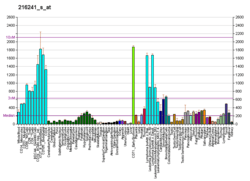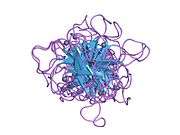TCEA1
Transcription elongation factor A protein 1 is a protein that in humans is encoded by the TCEA1 gene.[5][6][7]
Interactions
TCEA1 has been shown to interact with GTF2H1[8][9] and POLR2A.[8][9][10]
References
- 1 2 3 GRCh38: Ensembl release 89: ENSG00000187735 - Ensembl, May 2017
- 1 2 3 GRCm38: Ensembl release 89: ENSMUSG00000033813 - Ensembl, May 2017
- ↑ "Human PubMed Reference:".
- ↑ "Mouse PubMed Reference:".
- ↑ DiMarco SP, Glover TW, Miller DE, Reines D, Warren ST (Feb 1997). "Transcription elongation factor SII (TCEA) maps to human chromosome 3p22 --> p21.3". Genomics. 36 (1): 185–8. doi:10.1006/geno.1996.0443. PMID 8812434.
- ↑ Park H, Baek K, Jeon C, Agarwal K, Yoo O (Mar 1994). "Characterization of the gene encoding the human transcriptional elongation factor TFIIS". Gene. 139 (2): 263–7. doi:10.1016/0378-1119(94)90767-6. PMID 8112616.
- ↑ "Entrez Gene: TCEA1 transcription elongation factor A (SII), 1".
- 1 2 Archambault, J; Pan G; Dahmus G K; Cartier M; Marshall N; Zhang S; Dahmus M E; Greenblatt J (Oct 1998). "FCP1, the RAP74-interacting subunit of a human protein phosphatase that dephosphorylates the carboxyl-terminal domain of RNA polymerase IIO". J. Biol. Chem. UNITED STATES. 273 (42): 27593–601. doi:10.1074/jbc.273.42.27593. ISSN 0021-9258. PMID 9765293.
- 1 2 Pan, G; Aso T; Greenblatt J (Sep 1997). "Interaction of elongation factors TFIIS and elongin A with a human RNA polymerase II holoenzyme capable of promoter-specific initiation and responsive to transcriptional activators". J. Biol. Chem. UNITED STATES. 272 (39): 24563–71. doi:10.1074/jbc.272.39.24563. ISSN 0021-9258. PMID 9305922.
- ↑ Kettenberger, Hubert; Armache Karim-Jean; Cramer Patrick (Aug 2003). "Architecture of the RNA polymerase II-TFIIS complex and implications for mRNA cleavage". Cell. United States. 114 (3): 347–57. doi:10.1016/S0092-8674(03)00598-1. ISSN 0092-8674. PMID 12914699.
Further reading
- Chen HC, England L, Kane CM (1992). "Characterization of a HeLa cDNA clone encoding the human SII protein, an elongation factor for RNA polymerase II". Gene. 116 (2): 253–8. doi:10.1016/0378-1119(92)90522-Q. PMID 1378807.
- Kato H, Sumimoto H, Pognonec P, et al. (1992). "HIV-1 Tat acts as a processivity factor in vitro in conjunction with cellular elongation factors". Genes Dev. 6 (4): 655–66. doi:10.1101/gad.6.4.655. PMID 1559613.
- Yoo OJ, Yoon HS, Baek KH, et al. (1991). "Cloning, expression and characterization of the human transcription elongation factor, TFIIS". Nucleic Acids Res. 19 (5): 1073–9. doi:10.1093/nar/19.5.1073. PMC 333783. PMID 1708494.
- Reines D, Chamberlin MJ, Kane CM (1989). "Transcription elongation factor SII (TFIIS) enables RNA polymerase II to elongate through a block to transcription in a human gene in vitro". J. Biol. Chem. 264 (18): 10799–809. PMID 2471707.
- Qian X, Jeon C, Yoon H, et al. (1993). "Structure of a new nucleic-acid-binding motif in eukaryotic transcriptional elongation factor TFIIS". Nature. 365 (6443): 277–9. doi:10.1038/365277a0. PMID 7626141.
- Yeh CH, Shatkin AJ (1994). "A HeLa-cell-encoded p21 is homologous to transcription elongation factor SII". Gene. 143 (2): 285–7. doi:10.1016/0378-1119(94)90112-0. PMID 8206389.
- Umehara T, Kida S, Yamamoto T, Horikoshi M (1996). "Isolation and characterization of a cDNA encoding a new type of human transcription elongation factor S-II". Gene. 167 (1–2): 297–302. doi:10.1016/0378-1119(95)00634-6. PMID 8566795.
- Powell W, Bartholomew B, Reines D (1996). "Elongation factor SII contacts the 3'-end of RNA in the RNA polymerase II elongation complex". J. Biol. Chem. 271 (37): 22301–4. doi:10.1074/jbc.271.37.22301. PMC 3371613. PMID 8798387.
- Pan G, Aso T, Greenblatt J (1997). "Interaction of elongation factors TFIIS and elongin A with a human RNA polymerase II holoenzyme capable of promoter-specific initiation and responsive to transcriptional activators". J. Biol. Chem. 272 (39): 24563–71. doi:10.1074/jbc.272.39.24563. PMID 9305922.
- Li XY, Green MR (1998). "The HIV-1 Tat cellular coactivator Tat-SF1 is a general transcription elongation factor". Genes Dev. 12 (19): 2992–6. doi:10.1101/gad.12.19.2992. PMC 317190. PMID 9765201.
- Archambault J, Pan G, Dahmus GK, et al. (1998). "FCP1, the RAP74-interacting subunit of a human protein phosphatase that dephosphorylates the carboxyl-terminal domain of RNA polymerase IIO". J. Biol. Chem. 273 (42): 27593–601. doi:10.1074/jbc.273.42.27593. PMID 9765293.
- Suzuki H, Fukunishi Y, Kagawa I, et al. (2001). "Protein-protein interaction panel using mouse full-length cDNAs". Genome Res. 11 (10): 1758–65. doi:10.1101/gr.180101. PMC 311163. PMID 11591653.
- Strausberg RL, Feingold EA, Grouse LH, et al. (2003). "Generation and initial analysis of more than 15,000 full-length human and mouse cDNA sequences". Proc. Natl. Acad. Sci. U.S.A. 99 (26): 16899–903. doi:10.1073/pnas.242603899. PMC 139241. PMID 12477932.
- Saso K, Ito T, Natori S, Sekimizu K (2004). "Identification of a novel tissue-specific transcriptional activator FESTA as a protein that interacts with the transcription elongation factor S-II". J. Biochem. 133 (4): 493–500. doi:10.1093/jb/mvg065. PMID 12761297.
- Imabayashi H, Mori T, Gojo S, et al. (2003). "Redifferentiation of dedifferentiated chondrocytes and chondrogenesis of human bone marrow stromal cells via chondrosphere formation with expression profiling by large-scale cDNA analysis". Exp. Cell Res. 288 (1): 35–50. doi:10.1016/S0014-4827(03)00130-7. PMID 12878157.
- Kettenberger H, Armache KJ, Cramer P (2003). "Architecture of the RNA polymerase II-TFIIS complex and implications for mRNA cleavage". Cell. 114 (3): 347–57. doi:10.1016/S0092-8674(03)00598-1. PMID 12914699.
- Tamura K, Miyata K, Sugahara K, et al. (2003). "Identification of EloA-BP1, a novel Elongin A binding protein with an exonuclease homology domain". Biochem. Biophys. Res. Commun. 309 (1): 189–95. doi:10.1016/S0006-291X(03)01556-0. PMID 12943681.
- Zhang C, Yan H, Burton ZF (2004). "Combinatorial control of human RNA polymerase II (RNAP II) pausing and transcript cleavage by transcription factor IIF, hepatitis delta antigen, and stimulatory factor II". J. Biol. Chem. 278 (50): 50101–11. doi:10.1074/jbc.M307590200. PMID 14506279.
This article is issued from
Wikipedia.
The text is licensed under Creative Commons - Attribution - Sharealike.
Additional terms may apply for the media files.






